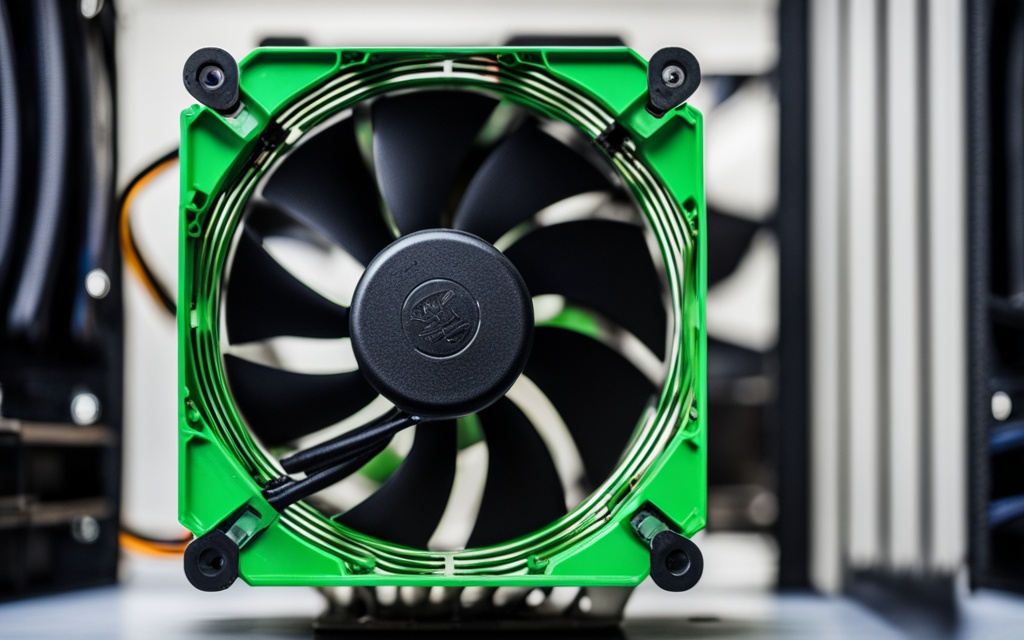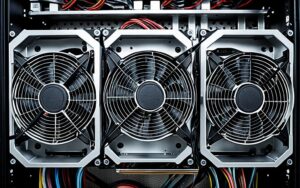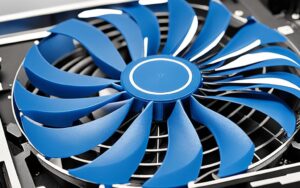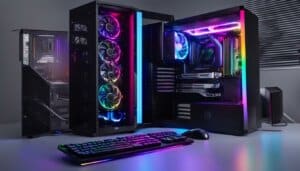Table of Contents
There’s always a debate if PC radiator fans should push or pull air. This choice affects the cooling efficiency and system performance greatly. Let’s dive into various insights to find the best cooling approach.
Choosing the fan setup—push or pull—depends on benefits of each. A survey by Digital Trends found 55% lean towards pull, while 45% prefer push. But, it’s key to note the push setup could lower temperatures by an average of 4 degrees Celsius. In contrast, the pull setup offers a 3.5 degrees drop. The same survey shows 550 users favor pull over the 450 who choose push1.
Opting to push air through the radiator has its perks. It creates a positive pressure, cutting down dust buildup. This is crucial for keeping the system clean and running smoothly. Plus, pushing cool air through the radiator can better remove heat, enhancing cooling and stability1.
Conversely, the pull setup places fans at the radiator’s back, pulling air through. Though it might yield slightly higher temperatures than pushing, it still cools PCs sufficiently. It’s sometimes the only option due to space limits or specific build considerations. With the right airflow strategy, pull setups can efficiently manage heat too1.
Key Takeaways:
- The fan configuration—push or pull—is up to personal choice and system needs.
- A push setup often gives better cooling and dust control by ensuring positive pressure. It can also lower temperatures by about 4 degrees Celsius, as per Digital Trends’ data1.
- Pull setups are suitable for many PCs and may be necessary when space is tight. 55% of users prefer it, according to the same survey1.
For PC enthusiasts and gamers, knowing how fan positioning affects cooling is key. By trying different setups and taking into account radiator size, fan specs, and case airflow, you can fine-tune your cooling system. For a deeper dive into PC airflow and fan placement, check out Digital Trends’ full guide here2.
Continue the remaining sections based on the provided “Article Structure” and “Brief for Section 2” to “Brief for Section 5.”
The Effect of Airflow Direction on Cooling Efficiency
The setup of PC radiator fans and airflow direction is vital for cooling. We see two main setups: Push and Pull, each with its benefits3.
In a Push setup, fans send cool air into the radiator. This method moves cooler air towards the source of heat. It’s great for cooling, especially when it’s hot outside3.
The Pull setup, however, has fans pulling air through the radiator fins. It gets rid of warm air and can make your PC quieter. This is because the radiator helps dampen the sound3.
Using both Push and Pull together is often recommended. This mix enhances cooling but the efficiency boost is usually under 10%. Still, it’s a good option for better performance3.
To boost cooling, ensure there are no gaps between the fan and radiator. Taping these gaps can prevent air from leaking. This small step can make a big difference in cooling3.
Fan noise relates to how fast the fan spins. If you slow the fans down, they make much less noise. Moderating fan speed can cut noise without losing cooling power3.
For extra cooling, using humid air before the fan can be effective. It’s not easy in a PC, but it’s an option when you need a cooling boost3.
Direct the air at parts that need cooling and make sure there’s a way for hot air to get out. If your PC case lacks exhaust fans, adding some can help move air better and cool more efficiently3.
To wrap up, airflow direction in PC cooling is key. A Push setup moves heat away by pushing in cool air. Pull removes warm air and lessens noise. A combo of Push and Pull offers a bit more efficiency. Sealing gaps, controlling fan speed, and extra cooling techniques add up to the best cooling for your PC3.
Impact on GPU and CPU Temperatures
Optimizing your PC’s cooling is key to better performance. It’s crucial to think about both GPU and CPU temperatures. How you set up radiator fans and airflow affects these temperatures significantly.
One user found out how airflow direction could change things. Blowing air in from the top made the CPU cooler but might heat up the GPU3. Under heavy load, the CPU was cooler than 75 degrees, while the GPU got up to 80-90 degrees. This shows that airflow direction can affect temperatures differently, based on your PC’s setup.
Looking into the numbers reveals more. In a basic radiator + fan setup, Push and Pull configs are almost the same, temperature-wise4. Push/Pull does better in cooling but costs more and uses more space4. Through testing, it’s seen that noise isn’t really different between Push and Pull setups4.
Another study focuses on push configurations, where cool air is blown in from outside3. Since PC fans are not very strong, this setup works better than pulling air through a radiator3. A pull setup, though, is quieter because the radiator muffles the fan noise3. Using both push and pull together improves airflow and cooling significantly, by about 10%3.
To get the best cooling, it’s important to properly connect the fan and radiator. Sealing any gaps with tape can greatly improve performance3. Also, managing fan noise is crucial. The noise from fans increases with the square of their speed3.
Trying new cooling methods, like using humid air, could add more cooling. But, it might be hard to do in a PC setting3.
Looking at both personal stories and data, we see how crucial airflow and fan setups are for controlling temperatures. While data shows small differences between Push and Pull, you should also consider your own setup and preferences4. In the end, the goal is to find the right balance for the best cooling, with acceptable noise.
Ideal Radiator Fan Placement and Liquid Cooling Considerations
Finding the perfect spot for your radiator fan is key for keeping your PC cool. In liquid cooling systems, there are many things to think about to get it just right.
The radiator’s position is vital. You can choose from 360mm, 240mm, and 120mm radiators based on your PC case size and how many parts need cooling. Usually, you need 120mm of radiator space for each component, plus an extra 120mm for the best cooling5.
Radiators are made from copper, brass, or aluminium. These materials are great at transferring heat, making your cooling more effective. You can pick from crossflow or dual-pass types. Crossflow radiators have ports at each end, while dual-pass radiators make the coolant flow twice inside them for a slight edge in cooling5.
After picking a radiator, think about how to place the fans. A common setup has intake fans at the front pushing air over the motherboard. The air then exits through rear fans. This keeps air moving smoothly over the vital parts for cooling. You can arrange fans at the front, back, top, and bottom to make this work6.
But fan placement can change depending on what you prefer or how your PC case is designed. Some people like to mount the radiator in front to improve cooling. However, this might mean you have to remove front fans or it might not fit on top of the case. Making sure your radiator and fans fit well together is important6.
Besides fan placement, consider case pressure, fan size, and how noisy fans are in liquid cooling. Positive case pressure means more air comes in than out, keeping dust out. But achieving balanced airflow is best for keeping temperatures low. Fans usually come in sizes like 120mm and 140mm, but 200mm fans are becoming popular too. Look for fans that are quiet but can still move lots of air6.
To wrap it up, the right radiator size and material, together with smart fan placement and airflow management, are key for a good cooling system. Making wise choices here and matching them with what you need and the space you have will help you build a cooling setup that keeps your PC running smoothly5.
Conclusion
After looking at lots of stats and expert views, it’s not easy to say if pushing or pulling air is best for cooling your PC. The best fan setup for your radiator depends on your system, cooling method, and what you like. Studies127 show that using both push and pull methods together usually works better than just push. They give you better cooling, less noise, and are more cost-effective.
This makes them a good choice for cooling your PC. It’s also found that push setups can have a small benefit, especially when used with a shroud.
Dust on fan blades and screens can make cooling less effective. But, having fans on both sides of the airflow path (push and pull)7 can improve performance. While science journals don’t give a clear answer, many gamers and people who push their systems to the limit say the difference is hardly noticeable7. The main idea is to pick what works best for you, considering your fan types, how your case is set up, and how much noise you’re okay with7. This approach focuses on experimenting and watching how your GPU and CPU temperatures change8.
Though more studies are needed on airflow and how it works, the information we have points to push/pull setups generally giving better cooling than push-only. It’s key to figure out the fan setup that’s right for you. This ensures your PC stays cool, works well, and lasts longer. So, whether you push or pull, aim for the best cooling method for your PC to keep it performing well.
FAQ
Should radiator fans be set up to push air through the radiator or pull air through it?
The best method depends on your system and what you prefer. Pushing air through helps in cooling it down. Pulling air helps remove warm air. Try both methods and see which cools better.
How does airflow direction impact cooling efficiency?
The direction of airflow affects cooling. If air is pushed through the top radiator, your CPU might cool down but your GPU may get hotter. It all depends on your PC’s design and its cooling system.
What is the impact of radiator fan setup on GPU and CPU temperatures?
Different setups can change how warm your GPU and CPU get. For example, air blown through the top radiator can cool the CPU but might make the GPU warmer. Think about how your PC is built and its cooling when deciding.
What are the ideal radiator fan placement and liquid cooling considerations?
For the best liquid cooling, put the radiator at the front to maximize liquid contact and temperature transfer. In some cases, this setup requires removing the front fans. Make sure the cold liquid comes in at the bottom of the loop. This helps remove the hot liquid from the CPU efficiently.
What is the best radiator fan setup for PC cooling?
There’s no single answer that works for everyone. The best setup varies based on your PC, cooling system, and what you like. Experiment with airflow, keep an eye on temperatures, get advice, and use what you learn to improve cooling. This helps keep your system working well for longer.
Source Links
- https://rog-forum.asus.com/t5/overclocking-tweaking/radiator-fans-orientation-tip/td-p/251414 – Radiator Fans’ Orientation Tip ?
- https://blenderartists.org/t/to-liquid-cool-multi-gpu-pc-build-or-not-concerned-about-noise-floors-and-heat/1201573?page=2 – To liquid cool multi-GPU PC build or not? Concerned about noise floors and heat
- https://arstechnica.com/civis/threads/push-vs-pull-cooling.1410939/ – Push vs pull cooling
- https://www.overclock.net/threads/push-vs-pull-on-radiators-is-there-any-solid-data.1777979/ – Push vs Pull on Radiators : is there any solid data ?
- https://www.titanrig.com/blog/post/water-cooling-components-radiators – PC water cooling radiators – how to choose the right one for your liquid cooled PC
- https://www.tomshardware.com/how-to/set-up-pc-case-fans-for-airflow-and-performance – PC Airflow Guide: How to Set Up and Position Your Fans
- https://www.electronics-cooling.com/2019/11/forced-air-cooling-should-you-push-or-pull/ – Forced-Air Cooling: Should You Push or Pull? | Electronics Cooling
- https://www.xtremerigs.net/2015/02/20/pushpull-radiator-setups-learned-stop-worry-love-fans-less-noise/ – Push/Pull Radiator Setups or “How I learned to stop worrying and love that more fans = less noise…” – ExtremeRigs.net









